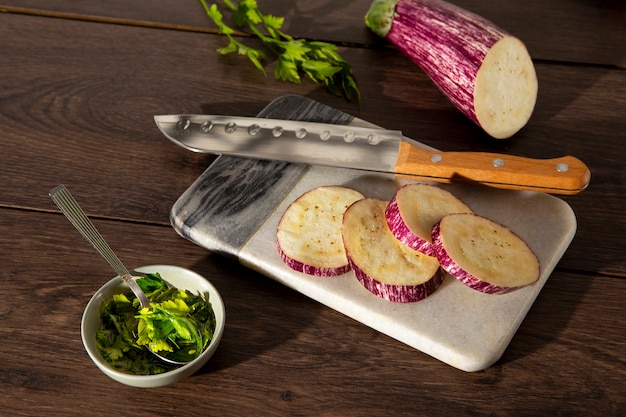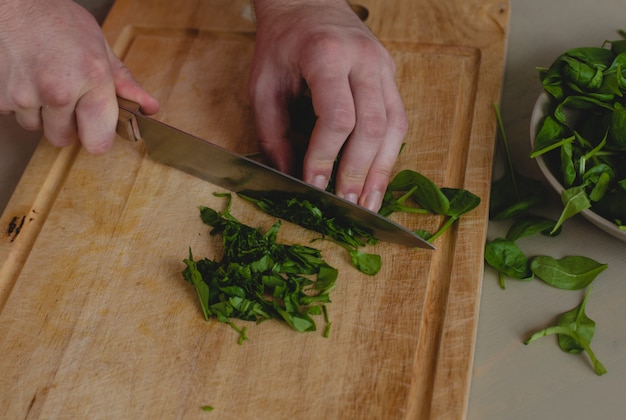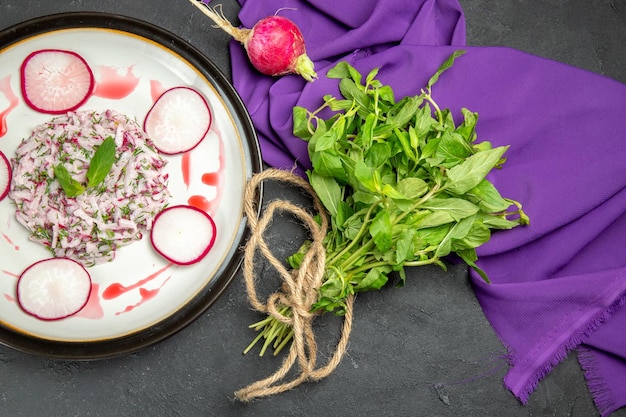As a seasoned cook, I'm always on the lookout for new and exciting ways to use seasonal ingredients. And let me tell you, Swiss chard is one of those vegetables that never fails to surprise me with its versatility. It can be transformed into hearty stews, light salads, and even delicious side dishes. But let's be honest, you might be thinking, "Swiss chard? Isn't that just a fancy name for spinach?" While both belong to the same family, Swiss chard has a distinctly different flavour and texture, which sets it apart. It boasts a slightly earthy, almost sweet taste, and the leaves are more robust than spinach. Once you've experienced the difference, you'll be hooked!
But enough about the basics. Let's get down to the nitty-gritty of Cooking with Swiss Chard. This guide will explore everything from choosing the perfect chard to preparing it for different recipes. We'll even delve into some of my personal favourite ways to cook this versatile green, with tips and tricks that will have you whipping up delicious chard dishes in no time.
(Part 1) Choosing the Right Swiss Chard

The first step to any great chard dish is selecting the right produce. You want chard that's fresh, vibrant, and free from any signs of spoilage. Here's what to look for when picking out your Swiss chard:
Look for Vibrant Green Leaves
Healthy Swiss chard will have vibrant green leaves that are free from wilting or yellowing. They should feel firm and crisp to the touch, not limp or soft. Avoid any leaves that have brown spots or seem damaged.
Check the Stems
Don't underestimate the importance of the stems! They're packed with flavour and nutrients. Look for stems that are firm and vibrant in colour, usually a bright white or even a light pink. Steer clear of stems that are soft or have brown spots, as this can indicate spoilage. Remember, these stems are too good to waste, so we'll explore delicious ways to use them later!
Think About Size
The size of the chard leaves is a matter of personal preference. Some people prefer smaller leaves, while others prefer larger leaves for specific dishes. But generally, you want to choose leaves that are evenly sized and not overly large, as they might be tougher to cook.
Remember: Fresh is Best
Just like with any other vegetable, fresh Swiss chard is always best. If you're shopping at a market or farm stand, talk to the vendor about when the chard was harvested. You'll want to choose chard that was picked recently for the best flavour and texture.
(Part 2) Getting Ready to Cook

Now that you've got your hands on some beautiful Swiss chard, it's time to prepare it for cooking. Follow these simple steps to ensure your chard is ready for culinary magic:
Washing and Trimming
Start by giving your chard a good wash. Rinse the leaves thoroughly under cold water to remove any dirt or debris. Then, trim off the tough ends of the stems, leaving about an inch of the stem intact. These stems are actually quite delicious, so don't throw them away!
Separating Leaves and Stems
Once you've trimmed the stems, you can separate the leaves from the stems. This is a simple process that involves gently pulling the leaves away from the stems. If you're using the stems for cooking, chop them into smaller pieces. The leaves can be used whole or chopped, depending on your recipe.
A Quick Tip: Don't Overcrowd
If you're cooking the leaves whole, try to avoid overcrowding the pan. Too much chard in a small pan can lead to steaming instead of sautéing, which can make the leaves soggy. Aim for a single layer of leaves in the pan to allow for even cooking.
(Part 3) The Beauty of Versatility: Cooking Methods

Swiss chard is incredibly versatile, which is why I love cooking with it so much. It can be cooked in so many different ways, each bringing out different flavours and textures. Let's explore some of the most common and delicious methods.
Sautéing: A Classic Choice
Sautéing is a great way to cook Swiss chard quickly and simply. It allows the leaves to soften while retaining a bit of their vibrant green colour. Heat a little olive oil or butter in a pan over medium heat. Add the chopped leaves and stems and cook until wilted, about 5-7 minutes, stirring occasionally. Season with salt and pepper to taste. You can also add a squeeze of lemon juice or a sprinkle of garlic powder for extra flavour.
Boiling: Quick and Easy
Boiling is another easy way to cook Swiss chard, especially when you're looking for a simple method to prepare it for soups or stews. Bring a pot of salted water to a boil. Add the chopped leaves and stems and cook until tender, about 3-5 minutes. Drain the chard and pat dry. The boiled chard can then be added to your favourite dishes.
Roasting: Bringing Out the Sweetness
Roasting brings out a subtle sweetness in Swiss chard and gives it a slightly caramelized flavour. It's a great way to prepare chard as a side dish or to add it to salads. Preheat your oven to 400 degrees Fahrenheit (200 degrees Celsius). Toss the chard leaves with olive oil, salt, and pepper. Spread the chard in a single layer on a baking sheet and roast for 15-20 minutes, or until tender.
(Part 4) Delicious Swiss Chard Recipes
Ready to get creative in the kitchen? Here are some of my favourite Swiss chard recipes that will make your tastebuds sing:
1. Swiss Chard and Sausage Stew
This hearty stew is perfect for a chilly evening. It's packed with flavour and texture, thanks to the combination of Swiss chard, sausage, and hearty vegetables. You can use any kind of sausage you like, but I prefer italian sausage for its bold flavour. This stew is also incredibly versatile; you can add other vegetables like potatoes, carrots, or beans to make it even more substantial.
Here's what you'll need:
- 1 pound Italian sausage, casings removed
- 1 onion, chopped
- 2 cloves garlic, minced
- 1 (28-ounce) can diced tomatoes, undrained
- 1 (14.5-ounce) can chicken broth
- 1 bunch Swiss chard, chopped
- 1/2 cup chopped fresh parsley
- Salt and pepper to taste
Instructions:
- In a large pot or dutch oven, brown the sausage over medium heat. Break it up with a spoon as it cooks.
- Add the onion and garlic to the pot and cook until softened, about 5 minutes.
- Stir in the diced tomatoes, chicken broth, and Swiss chard. Bring the mixture to a boil, then reduce heat to low and simmer for 15-20 minutes, or until the chard is tender.
- Stir in the parsley and season with salt and pepper to taste.
- Serve hot with crusty bread.
2. Creamy Swiss Chard and Mushroom Pasta
This creamy pasta dish is a real crowd-pleaser. It combines the earthy flavours of Swiss chard and mushrooms with a rich, creamy sauce. It's one of those dishes that is both comforting and sophisticated, perfect for a weeknight dinner or a special occasion. You can experiment with different pasta shapes for added texture and visual appeal.
Here's what you'll need:
- 1 pound pasta, your choice
- 1 tablespoon olive oil
- 1 onion, chopped
- 2 cloves garlic, minced
- 1 pound mushrooms, sliced
- 1 bunch Swiss chard, chopped
- 1/2 cup heavy cream
- 1/4 cup grated Parmesan cheese
- Salt and pepper to taste
Instructions:
- Bring a large pot of salted water to a boil and cook the pasta according to package directions.
- While the pasta is cooking, heat the olive oil in a large skillet over medium heat. Add the onion and cook until softened, about 5 minutes.
- Add the garlic and mushrooms to the skillet and cook until the mushrooms are golden brown, about 5 minutes.
- Stir in the Swiss chard and cook until wilted, about 3 minutes.
- Pour the heavy cream into the skillet and bring the mixture to a simmer.
- Stir in the Parmesan cheese until melted. Season with salt and pepper to taste.
- Drain the pasta and add it to the skillet with the sauce. Toss to coat.
- Serve immediately.
3. Swiss Chard and Feta Salad
This salad is light and refreshing, perfect for a summer lunch or dinner. The combination of Swiss chard, feta cheese, and a tangy vinaigrette is simply irresistible. It's also very versatile, and you can add other ingredients to suit your taste, such as chopped walnuts, dried cranberries, or roasted red peppers. For a more substantial salad, consider adding grilled chicken or chickpeas.
Here's what you'll need:
- 1 bunch Swiss chard, chopped
- 1/2 cup crumbled feta cheese
- 1/4 cup olive oil
- 2 tablespoons lemon juice
- 1 teaspoon Dijon mustard
- Salt and pepper to taste
Instructions:
- In a large bowl, combine the Swiss chard and feta cheese.
- In a small bowl, whisk together the olive oil, lemon juice, and Dijon mustard until emulsified. Season with salt and pepper to taste.
- Pour the dressing over the salad and toss to coat.
- Serve immediately.
(Part 5) Exploring Other Culinary Uses
Beyond these classic recipes, Swiss chard can be used in countless other ways. It can be added to soups, stews, quiches, pizzas, and even smoothies. And let's not forget about the stems! They are an excellent source of fibre and nutrients and can be used in stir-fries, roasted vegetables, or even pickled.
Getting Creative with Swiss chard stems
Don't toss those stems away! They are a nutritional powerhouse and add a delightful crunch to many dishes. Try them in the following ways:
- Sautéed stems: Simply sauté the chopped stems with garlic and olive oil until tender. Season with salt and pepper to taste. You can add them to pasta dishes, stir-fries, or use them as a base for a delicious frittata.
- Roasted stems: Toss the stems with olive oil, salt, and pepper and roast in the oven until tender. They make a great side dish or can be added to salads. Add some chopped walnuts or almonds for extra flavour and texture.
- Pickled stems: If you're feeling adventurous, try pickling the stems. They add a tangy and crunchy element to any meal. They're a perfect accompaniment to charcuterie boards or grilled meats.
(Part 6) Swiss Chard: A Nutritional Powerhouse
Swiss chard is not only delicious but also incredibly nutritious. It's packed with vitamins, minerals, and antioxidants that can benefit your overall health.
Key Nutritional Benefits
Here are some of the key nutritional benefits of Swiss chard:
- Rich in Vitamins: Swiss chard is an excellent source of vitamins A, C, and K, which are important for healthy vision, immune function, and blood clotting. Vitamin A is also essential for healthy skin and hair.
- Mineral Powerhouse: It's also a good source of minerals such as calcium, magnesium, potassium, and iron, which are essential for bone health, muscle function, and energy production. Calcium is also important for strong teeth.
- Antioxidant Boost: Swiss chard contains a variety of antioxidants, including lutein and zeaxanthin, which can help protect your eyes from damage. These antioxidants also have anti-inflammatory properties.
- Fibre Rich: It's also a good source of fibre, which is important for digestive health and can help you feel full and satisfied. Fibre also helps regulate blood sugar levels.
(Part 7) Tips for Storing Swiss Chard
To keep your Swiss chard fresh and flavorful, follow these storage tips:
Refrigeration is Key
Swiss chard should be stored in the refrigerator. Wrap the leaves in a damp paper towel and place them in a plastic bag. Store them in the crisper drawer for up to 5 days.
Freezing Option
If you plan to store the chard for a longer period, you can freeze it. Wash and chop the leaves and stems, then blanch them in boiling water for 2-3 minutes. Drain the chard and pat it dry. Place the chard in freezer bags and freeze for up to 3 months. Once frozen, you can add it to soups, stews, or other dishes without thawing.
Avoid Excess Moisture
Excess moisture can lead to spoilage. Make sure to dry the chard thoroughly before storing it.
(Part 8) FAQs
Here are some frequently asked questions about Swiss chard:
1. How do I tell if Swiss chard is bad?
If the leaves are wilted, yellowed, or have brown spots, it's best to throw them away. The stems should be firm and vibrant in colour. If they are soft or have brown spots, the chard may be spoiled.
2. Can I substitute spinach for Swiss chard?
While spinach and Swiss chard are both members of the same family, they have different flavours and textures. You can substitute spinach for Swiss chard in some recipes, but the flavour and texture will be different. Spinach has a milder flavour and a more delicate texture than Swiss chard. If you are making a salad, spinach might be a good substitute, but for a stew or a dish where you want a more robust flavour, Swiss chard is a better choice.
3. What are the best ways to cook Swiss chard stems?
Swiss chard stems are delicious and nutritious! You can sauté, roast, pickle, or add them to soups and stews. They add a delightful crunch to many dishes. Try using them in stir-fries, pasta dishes, or even as a topping for pizzas.
4. How long does it take to cook Swiss chard?
The cooking time for Swiss chard depends on the cooking method. It usually takes about 5-7 minutes to sauté, 3-5 minutes to boil, and 15-20 minutes to roast.
5. What are some other ways to use Swiss chard?
Swiss chard is a versatile vegetable that can be used in countless ways. Try adding it to soups, stews, quiches, pizzas, smoothies, or even stir-fries. You can also use the stems in pickled dishes or as a side dish. Get creative and experiment with different flavours and combinations!
(Part 9) Conclusion: Embrace the Versatility
And that, my friends, is the beauty of Swiss chard. It's a versatile vegetable that can be cooked in a variety of ways, adding flavour and nutrition to any meal. From hearty stews to light salads, there's a Swiss chard recipe out there for everyone. So next time you're at the market, pick up a bunch of this leafy green and get ready to explore its culinary possibilities. You might just be surprised at how delicious and versatile this humble vegetable truly is!
Everyone is watching

How to Cook Frozen Lobster Tails Perfectly: A Step-by-Step Guide
RecipesLobster. Just the word conjures up images of lavish meals, special occasions, and a taste of luxury. But let's...

Pigs in a Blanket Cooking Time: How Long to Bake for Perfect Results
RecipesAh, pigs in a blanket. Just the name conjures up images of those delightful little parcels of crispy pastry en...

Pork Fillet Cooking Time: How Long to Cook It Perfectly
RecipesPork fillet, or tenderloin as it's sometimes called, is a real favourite in our house. It's so versatile, and...

The Ultimate Guide to Cooking Delicious Frankfurters
RecipesLet's face it, we all love a good frankfurter. It's a classic, simple, and always satisfying. But let's be rea...

Wolf Meat Recipes: A Guide to Cooking Wild Game
RecipesLet's be honest, you don't see wolf meat at your local butcher shop every day. It's a bit of a wild card, but ...
